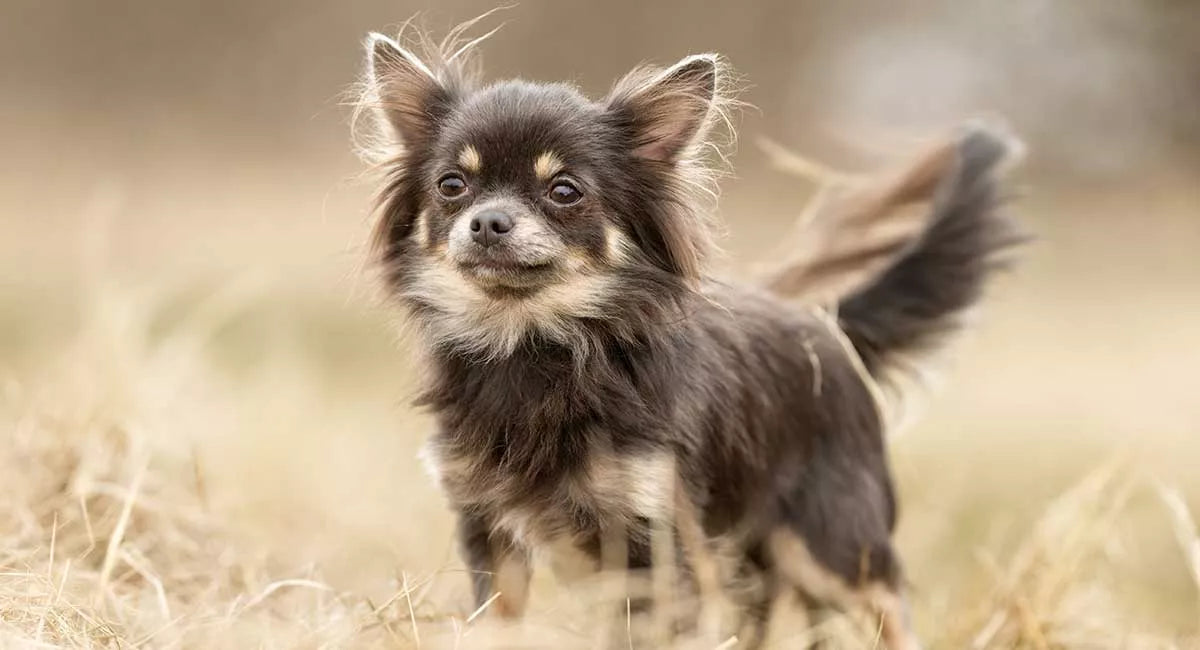Chihuahua Fact and Figures

Spirited, intelligent and curious, Chihuahuas respond especially well to strong human leadership and guidance. They are fastidious, can be highly strung and prone to stress, but will reward you with boundless loyalty.
Although their name suggests they are native to Mexico, no one really knows where they came from. One theory suggests their ancestors are the Techichi, companions of the Toltec people since at least the 9th century. Other archaeological evidence suggests they might be older.
Chihuahuas come in two main varieties, long haired and short haired, and with two main shapes of head, “apple” and “deer” although only the apple head is regarded as “conforming” to breed standards.
Muzzles are short, eyes are large, and round, and well spaced, and usually dark or ruby red. Ears are large and erect. Some common coat colours are chestnut, black, white, sand, fawn, sable, black and tan, and silver.
These feisty little dogs range from 15 cm to about 23 cm (6 to 9 inches) although some grow as tall as 30cm or even 38 cm (12 to 15 inches). According to breed standards, a Chihuahua must weigh no more than 2.7kg, or 6 1b. Ideally, the dog should weigh between 1.8–2.7 kg (4–6 lb).
Staying healthy
These dogs may be small, but they are tough. Keep them healthy by making sure they are warm and have enough space to run around. They need a lot of exercise – without it they can tend to get fat. They may also be prone to colds and rheumatism and have problems with gums or eyes.
One peculiar feature of this breed is that they may have a molera, part of the skull which is not closed at birth and may remain this way through life – making them prone to infections. They may need regular teeth cleaning, and keep an eye on their jaw structure which can be affected as they age – due to their size, they benefit from small and frequent meals of good “doggy” food.
How long do they live?
Chihuahuas live for around 15 years on average. These sturdy little creatures are ideal indoor dogs, or if you only have a small garden. If properly trained, they make ideal companions for children. Do not be fooled by the fact these dogs are physically little – what they lack in size they more than make up with sheer spirit.
Although their name suggests they are native to Mexico, no one really knows where they came from. One theory suggests their ancestors are the Techichi, companions of the Toltec people since at least the 9th century. Other archaeological evidence suggests they might be older.
Chihuahuas come in two main varieties, long haired and short haired, and with two main shapes of head, “apple” and “deer” although only the apple head is regarded as “conforming” to breed standards.
Muzzles are short, eyes are large, and round, and well spaced, and usually dark or ruby red. Ears are large and erect. Some common coat colours are chestnut, black, white, sand, fawn, sable, black and tan, and silver.
These feisty little dogs range from 15 cm to about 23 cm (6 to 9 inches) although some grow as tall as 30cm or even 38 cm (12 to 15 inches). According to breed standards, a Chihuahua must weigh no more than 2.7kg, or 6 1b. Ideally, the dog should weigh between 1.8–2.7 kg (4–6 lb).
Staying healthy
These dogs may be small, but they are tough. Keep them healthy by making sure they are warm and have enough space to run around. They need a lot of exercise – without it they can tend to get fat. They may also be prone to colds and rheumatism and have problems with gums or eyes.
One peculiar feature of this breed is that they may have a molera, part of the skull which is not closed at birth and may remain this way through life – making them prone to infections. They may need regular teeth cleaning, and keep an eye on their jaw structure which can be affected as they age – due to their size, they benefit from small and frequent meals of good “doggy” food.
How long do they live?
Chihuahuas live for around 15 years on average. These sturdy little creatures are ideal indoor dogs, or if you only have a small garden. If properly trained, they make ideal companions for children. Do not be fooled by the fact these dogs are physically little – what they lack in size they more than make up with sheer spirit.
-
Posted in
a guide to the Chihuahua, Chihuahua quick guide





